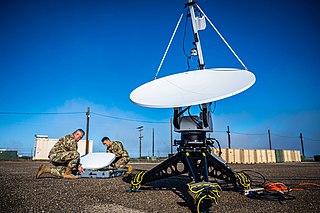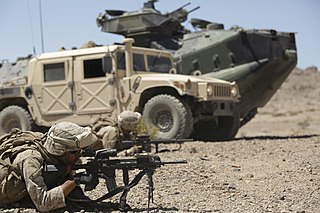The United States Armed Forces are the military forces of the United States. The armed forces consist of six service branches: the Army, Marine Corps, Navy, Air Force, Space Force, and Coast Guard. All six armed services are among the eight uniformed services of the United States, along with the U.S. Public Health Service Commissioned Corps and the NOAA Commissioned Officer Corps.

Electromagnetic warfare or electronic warfare (EW) is warfare involving the use of the electromagnetic spectrum or directed energy to control the spectrum, attack an enemy, or impede enemy operations. The purpose of electromagnetic warfare is to deny the opponent the advantage of—and ensure friendly unimpeded access to—the EM spectrum. Electromagnetic warfare can be applied from air, sea, land, or space by crewed and uncrewed systems, and can target communication, radar, or other military and civilian assets.
A revolution in military affairs (RMA) is a hypothesis in military theory about the future of warfare, often connected to technological and organizational recommendations for military reform.
AirLand Battle was the overall conceptual framework that formed the basis of the US Army's European warfighting doctrine from 1982 into the late 1990s. AirLand Battle emphasized close coordination between land forces acting as an aggressively maneuvering defense, and air forces attacking rear-echelon forces feeding those front line enemy forces. AirLand Battle replaced 1976's "Active Defense" doctrine, and was itself replaced by "Full Spectrum Operations" in 2001.

Maneuver warfare, or manoeuvre warfare, is a military strategy which emphasizes movement, initiative and surprise to achieve a position of advantage. Maneuver seeks to inflict losses indirectly by envelopment, encirclement and disruption, while minimizing the need to engage in frontal combat. In contrast to attrition warfare where strength tends to be applied against strength, maneuver warfare attempts to apply strength against weakness in order to accomplish the mission.
In warfare, a theater or theatre is an area in which important military events occur or are in progress. A theater can include the entirety of the airspace, land, and sea area that is—or that may potentially become—involved in war operations.
Network-centric warfare, also called network-centric operations or net-centric warfare, is a military doctrine or theory of war that aims to translate an information advantage, enabled partly by information technology, into a competitive advantage through the computer networking of dispersed forces. It was pioneered by the United States Department of Defense in the 1990s.
Joint warfare is a military doctrine that places priority on the integration of the various branches of a state's armed forces into one unified command. Joint warfare is in essence a form of combined arms warfare on a larger, national scale, in which complementary forces from a state's army, navy, air, coastal, space, and special forces are meant to work together in joint operations, rather than planning and executing military operations separately.

Land warfare or ground warfare is the process of military operations eventuating in combat that takes place predominantly on the battlespace land surface of the planet.
Battlespace or battle-space is a term used to signify a military strategy which integrates multiple armed forces for the military theatre of operations, including air, information, land, sea, cyber and outer space to achieve military goals. It includes the environment, timeframe and other factors, and conditions that must be understood to successfully apply combat power, protect the force, or complete the mission. This includes enemy and friendly armed forces, infrastructure, weather, terrain, and the electromagnetic spectrum within the operational areas and areas of interest.
Shock and awe is a military strategy based on the use of overwhelming power and spectacular displays of force to paralyze the enemy's perception of the battlefield and destroy their will to fight. Though the concept has a variety of historical precedents, the doctrine was explained by Harlan K. Ullman and James P. Wade in 1996 and was developed specifically for application by the US military by the National Defense University of the United States.
The following outline is provided as an overview of and topical guide to military science:

Command and control is a "set of organizational and technical attributes and processes ... [that] employs human, physical, and information resources to solve problems and accomplish missions" to achieve the goals of an organization or enterprise, according to a 2015 definition by military scientists Marius Vassiliou, David S. Alberts, and Jonathan R. Agre. The term often refers to a military system.
In the United States Army, the term combat support refers to units that provide fire support and operational assistance to combat elements. Combat support units provide specialized support functions to combat units in the following areas
Effects-based operations (EBO) is a United States military concept that emerged during the Persian Gulf War for the planning and conduct of operations combining military and non-military methods to achieve a particular effect. An effects-based approach to operations was first applied in modern times in the design and execution of the Desert Storm air campaign of 1991. The principal author of the daily attack plans—then Lt Colonel, now retired Lt General David A. Deptula—used an effects-based approach in building the actual Desert Storm air campaign targeting plan. Deptula describes the background, rationale, and provides an example of how an effects-based approach to targeting was conducted in Desert Storm in the publication, "Effects-Based Operations: Change in the Nature of Warfare." The doctrine was developed with an aim of putting desired strategic effects first and then planning from the desired strategic objective back to the possible tactical level actions that could be taken to achieve the desired effect. Contrary to conventional military approaches of force-on-force application that focused on attrition and annihilation, EBO focused on desired outcomes attempting to use a minimum of force. The approach was enabled by advancements in weaponry—particularly stealth and precision weapons—in conjunction with a planning approach based on specific effects rather than absolute destruction. Deptula, speaking at the Gulf War Air Campaign Tenth Anniversary Retrospective, on 17 January 2001 on One Massachusetts Avenue, NW, Washington, DC, defined the goal of EBO; "If we focus on effects, the end of strategy, rather than force-on-force the traditional means to achieve it militarily, that enables us to consider different and perhaps more effective ways to accomplish the same goal quicker than in the past, with fewer resources and most importantly with fewer casualties." Others have postulated that EBO could be interpreted as an emerging understanding that attacking a second-order target may have first order consequences for a variety of objectives, wherein the Commander's intent can be satisfied with a minimum of collateral damage or risk to his own forces.

The Navy Expeditionary Combat Command (NECC) is an echelon III command of the United States Navy, which serves as the single functional command to centrally manage current and future readiness, resources, manning, training and equipping of the United States Navy's 21,000 expeditionary forces who are currently serving in every theater of operation. The NECC was established in January 2006. NECC is a subordinate command of the Navy's Fleet Forces Command.
LandWarNet (LWN) is the United States Army’s contribution to the Global Information Grid (GIG) that consists of all globally interconnected, end-to-end set of Army information capabilities, associated processes, and personnel for collecting, processing, storing, disseminating, and managing information on demand supporting warfighters, policy makers, and support personnel. It includes all Army and leveraged Department of Defense (DOD)/Joint communications and computing systems and services, software, data security services, and other associated services. LandWarNet exists to enable the warfighter through Mission Command, previously described as Battle Command. Other U.S. service equivalent efforts to LandWarNet include the Navy's "FORCEnet" and the Air Force's "C2 Constellation."
The reconnaissance mission within the United States Marine Corps is divided into two distinct but complementary aspects; Marine Division Recon and Force Reconnaissance.
Information Operations is a category of direct and indirect support operations for the United States Military. By definition in Joint Publication 3-13, "IO are described as the integrated employment of electronic warfare (EW), computer network operations (CNO), psychological operations (PSYOP), military deception (MILDEC), and operations security (OPSEC), in concert with specified supporting and related capabilities, to Information Operations (IO) are actions taken to affect adversary information and information systems while defending one's own information and information systems.
The fifth dimension of warfare complements the four classical dimensions: land, sea, air, and space. It was enunciated in 1995 as information operations.





